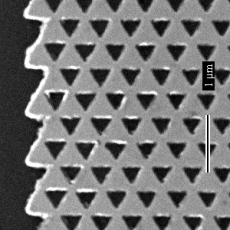Discovery - In The Nano World
The Center for Advanced Nanoscience (CAN) brings together, under a single umbrella, expertise in diverse areas such as; thin films, lithography, self-assembly, physics, chemistry, quantum technology, biochemistry, neutron and synchrotron scattering, and scanning probe techniques.
Read moreTools and Imagination...
Magnetic, superconducting, organic, oxide, boride and nitride materials are being explored in a variety of nanostructured configuration and devices like the Organic Molecular Beam Epitaxy (MBE).
Read moreNano Links
The Center for Advanced Nanoscience is located on the beautifully scenic UCSD campus in San Diego, both of which offer a wealth of exciting activities and things to see, some of which you can read more information about here.
Read moreCool Things Nanoscientists Do
The week may find them spending their hours doing research in labs, but nanoscientists do a lot more than just research! Come see some of the exciting adventures that our faculty haven taken over the years.
Read morePattern of the Day

CAN in the News
| 2013-04-01 | Metal Oxides Show Promise as Transistors |
| The switches in most electronic circuits are made of silicon, one of the commonest elements. But their successors might contain materials that, for now, are lab-grown oddities: strongly correlated metal oxides. | |
| 2013-03-30 | Metal Oxide work highlighted in Nature |
| Ivan Schuller’s recent work on Metal Oxides was highlighted in Nature | |
| 2013-03-29 | Robust Quantum Entanglement at a Distance (Sham Group) |
| Chris Chan and Lu Sham’s theory on using the more robust multiphoton states to entangle two distant electron spins is published in PRL. The proposed method has the potential of much higher probability of success in entanglement by measurement projection than the current single photon method. Entanglement of two spins in two separate quantum dots is the requisite precursor to quantum information processing in semiconductor systems. | |
| 2013-03-28 | Anisotropic capillary wave dynamics on “groovy” substrates (Shpyrko Group) |
| Liquid surfaces are generally known to be isotropic—any two orthogonal directions along their surfaces are equivalent. Thermally excited capillary fluctuations are nanometer high waves that spontaneously decorate liquid surfaces even in the absence of external vibrations. As reported here, however, patterning the underlying substrate fundamentally changes how capillary waves propagate along various directions of the surface. | |
| 2013-03-19 | Earlier Versions of Mona Lisa are revealed (research by John Asmus) |
| Earlier versions of Mona Lisa painting revealed, see the book chapter by UCSD CAN researcher John Asmus | |
| 2013-02-20 | SDEC February 20th meeting: John Asmus "Seeing Double: Leonardo's Mona Lisa Twin" |
| Dr. John F. Asmus (FN' 97), a Research Physicist at UCSD, will be presenting "Seeing Double: Leonardo's Mona Lisa Twin." | |
| 2011-10-18 | Physics at the Nanoscale (A Symposium in Honor of Ivan Schuller) |
| Running from October 18-21 in Madrid, Spain, Physics at the Nanoscale has called the attention of an increasing number of researchers coming from different fields. In addition to Physics, Chemistry, Biology, Engineering are research fields which are strongly engaged in this hot topic. | |
| 2011-09-19 | SRC and National Science Foundation Award $20 Million to Fund U.S. University Research on Nanoelectronics for 2020 and Beyond |
| Professor Lu Sham of CAN and Physics is a Co-Principal investigator of an interdisciplinary multi-university collaboration on "Developing a Graphene Spin Computer: Materials, Nano-Devices, Modeling, and Circuit", which has just been awarded a grant under the "Nanoelectronics for 2020 and Beyond" competition, supported by the National Science Foundation and the Nanoelectronics Research Initiative of the Semiconductor Research Corporation. |